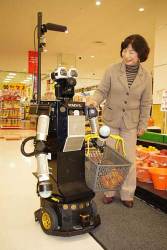Robot Robovie-II helps the elderly buy their groceries
 When we started this website we wanted to focus on robots made to aid us in various circumstances. Assisting the elderly is certainly one of the more noble jobs they can be given, and that’s just what Robovie-II, the creation of the Advanced Telecommunications Research Institute International (ATR) has been programmed to do. For the next few months, through to March 2010, it will assist selected elderly customers at a supermarket in Kyoto, Japan.
When we started this website we wanted to focus on robots made to aid us in various circumstances. Assisting the elderly is certainly one of the more noble jobs they can be given, and that’s just what Robovie-II, the creation of the Advanced Telecommunications Research Institute International (ATR) has been programmed to do. For the next few months, through to March 2010, it will assist selected elderly customers at a supermarket in Kyoto, Japan.
ATR sells a number of different robots which assist people in need in their homes, which can often be customized to an individual’s specific needs. To use the system, shoppers first create a shopping list at home using a special mobile device (they simply tell the robot’s on-screen avatar what they want to buy before going to the supermarket). Later, when the customer arrives at the store, sensors automatically detect the mobile device. The user’s data is wirelessly transmitted to a waiting robot, which greets the customer by name and says, “Let’s start shopping.”
In the video above, which shows part of a test conducted on December 10, the child-sized robot accompanies a 67-year-old woman while she shops for mandarin oranges and broccoli. In addition to carrying the woman’s shopping basket, the robot reminds her to get the mandarin oranges, recommends the apples (which the robot says are delicious this season), reminds her to get the broccoli, and suggests including lettuce in her salad along with the broccoli. On several occasions, the robot remarks on how delicious the items look.
When asked her impression of the system after the demonstration, the woman said she felt almost as if she were shopping with her grandchild, and she said it was fun talking with the robot. A contribution to her statement were the robot’s amusing high-pitched voice, its child-like size and programmed wittiness in its statements as the “Mandarins oranges are tasty, aren’t they? I want to eat one.”
Regarding Robovie-II’s design, we agree with its designers only in one of their statements, and that is keeping the robot non-humanoid. Although their small size makes them seem less threatable, it also makes them less functional. Instead designing them with hands which carry shopping basket, they should have added a shopping cart to their back. That would also free the robot’s hands for additional help to elderly.
The question of privacy of our personal information and preferences opposed to the constant nagging from the stores sponsors masked as robot’s recommendations is also raised. As most of the products we buy get an RFID tag (or the future equivalent of the same), the robot can easily check the items on our shopping list and reassure or warn us about the expiration date.
The last serious remark about this robot is its moving speed. Its developers must work on a better algorithm which would allow it to follow the shopper in various and adaptable speeds, thus making it useful.
Similar aiding robots should emerge much more often than the ones made for military. Hence, despite all the remarks, we have to praise this project as a right step in robot development.










Leave your response!